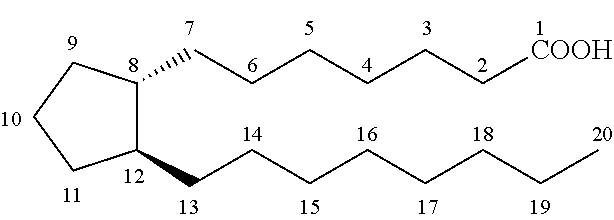Compositions and methods for lowering intraocular pressure
a technology of intraocular pressure and compositions, applied in the direction of organic active ingredients, pharmaceutical delivery mechanisms, inorganic non-active ingredients, etc., can solve the problems of affecting the drainage of aqueous humor, increasing the iop observed in primary glaucoma, and secondary glaucoma, so as to increase the aqueous humor outflow, reduce the iop, and enhance the uveoscleral outflow
- Summary
- Abstract
- Description
- Claims
- Application Information
AI Technical Summary
Problems solved by technology
Method used
Image
Examples
example ii
IOP Lowering Effect of the Triple Combination Product of Table 11
[0111]A 71 year old Caucasian male is suffering from open angle glaucoma and elevated intraocular pressure which is threatening to worsen his vision if left untreated. After three months on combination therapy, the patient's IOP was not lowered to the satisfaction of his physician. The 71 year old Caucasian begins daily dosing in both eyes of the Triple Combination of Table 11 and the patient is expected to experience adequate lowering of IOP that was not achievable.
EXAMPLE III
IOP Lowering of the Triple Combination Product of Table 11 in a 64 Year African American Female
[0112]A 64 year old African American female suffering from glaucoma is having difficulty lowering her IOP adequately with combination therapy product of brimonidine and timolol. After four months of combination therapy of the brimonidine and timolol product, her physician switches her to the Triple Combination therapy product in Table 11. After three we...
example iii
Treatment of Glaucoma of a 57 Year Old Caucasian Female
[0113]A 57 year old Caucasian female suffering from open-angle glaucoma has been largely non-responsive to first monotherapy and then combination therapy for lowering IOP. She switches to twice daily dosing of the composition in Table 11 and her IOP is expected to return to normal levels. After 30 days of dosing both eyes with the formulation of Table 11, the 57 year old Caucasian female's IOP returns to normal levels as long as she continues dosing with the formulation of Table 11.
example iv
Treatment of Elevated Intraocular Pressure in a 61 Year Old Asian Male
[0114]A 61 year old Asian male IOP was measured with a tonometer as being between 21.3 mmHg and 23.7 mmHg. Both monotherapy and combination therapy with various therapeutic agents known to lower IOP failed to bring the patient's IOP to acceptable levels. The patient began taking twice a day administration of the formulation of Table 11, with a single drop per eye in the morning and a single drop per eye 12 hours later in the evening. After 31 days, the patient's IOP is expected to lower to between 16.1-18.2 mmHg which is considered acceptable. After 90 days, the patient's IOP is expected to lower to between 15.5-16.8 mmHg.
PUM
| Property | Measurement | Unit |
|---|---|---|
| volume | aaaaa | aaaaa |
| intraocular pressure | aaaaa | aaaaa |
| pharmaceutical composition | aaaaa | aaaaa |
Abstract
Description
Claims
Application Information
 Login to View More
Login to View More - R&D
- Intellectual Property
- Life Sciences
- Materials
- Tech Scout
- Unparalleled Data Quality
- Higher Quality Content
- 60% Fewer Hallucinations
Browse by: Latest US Patents, China's latest patents, Technical Efficacy Thesaurus, Application Domain, Technology Topic, Popular Technical Reports.
© 2025 PatSnap. All rights reserved.Legal|Privacy policy|Modern Slavery Act Transparency Statement|Sitemap|About US| Contact US: help@patsnap.com

